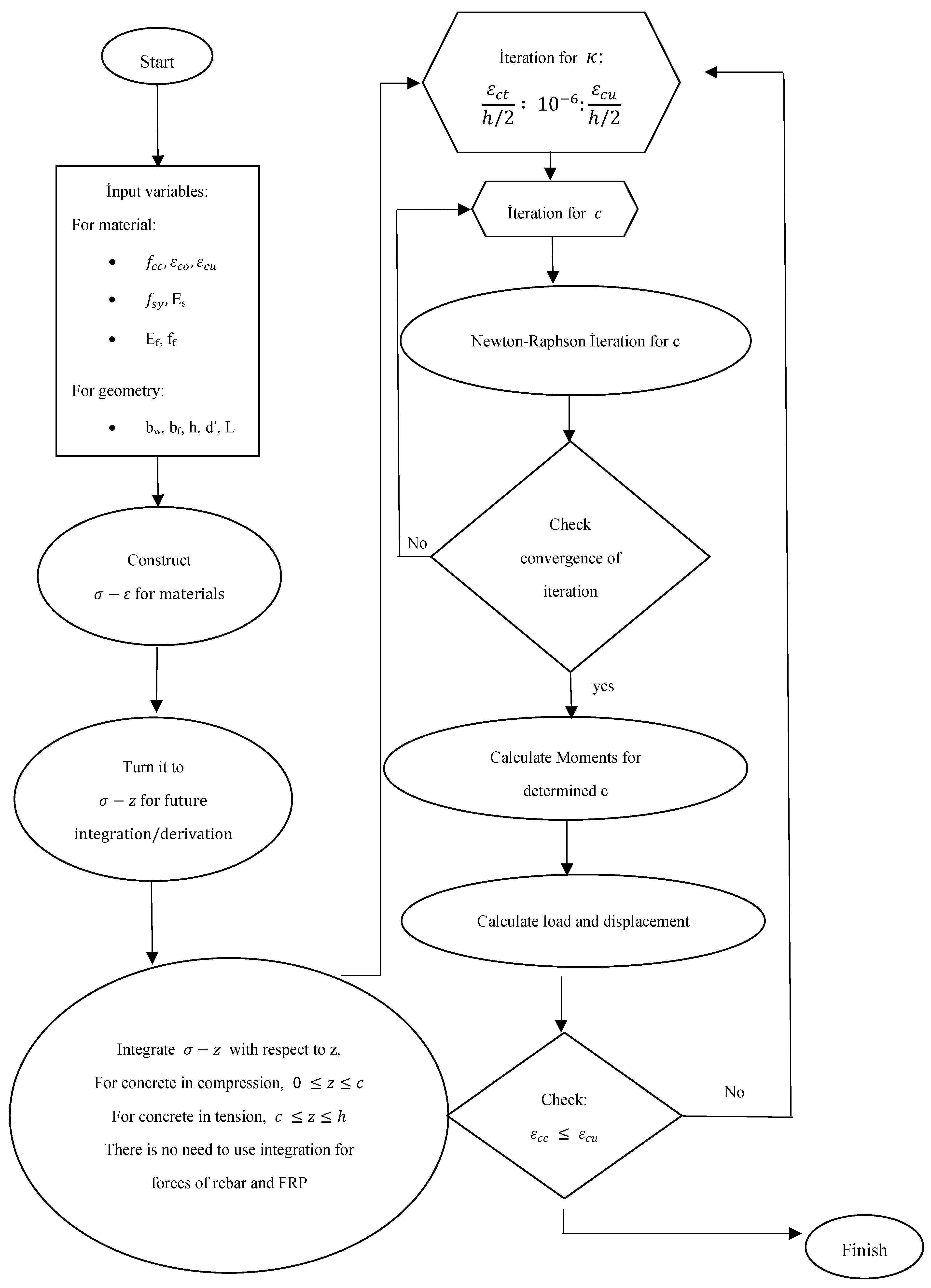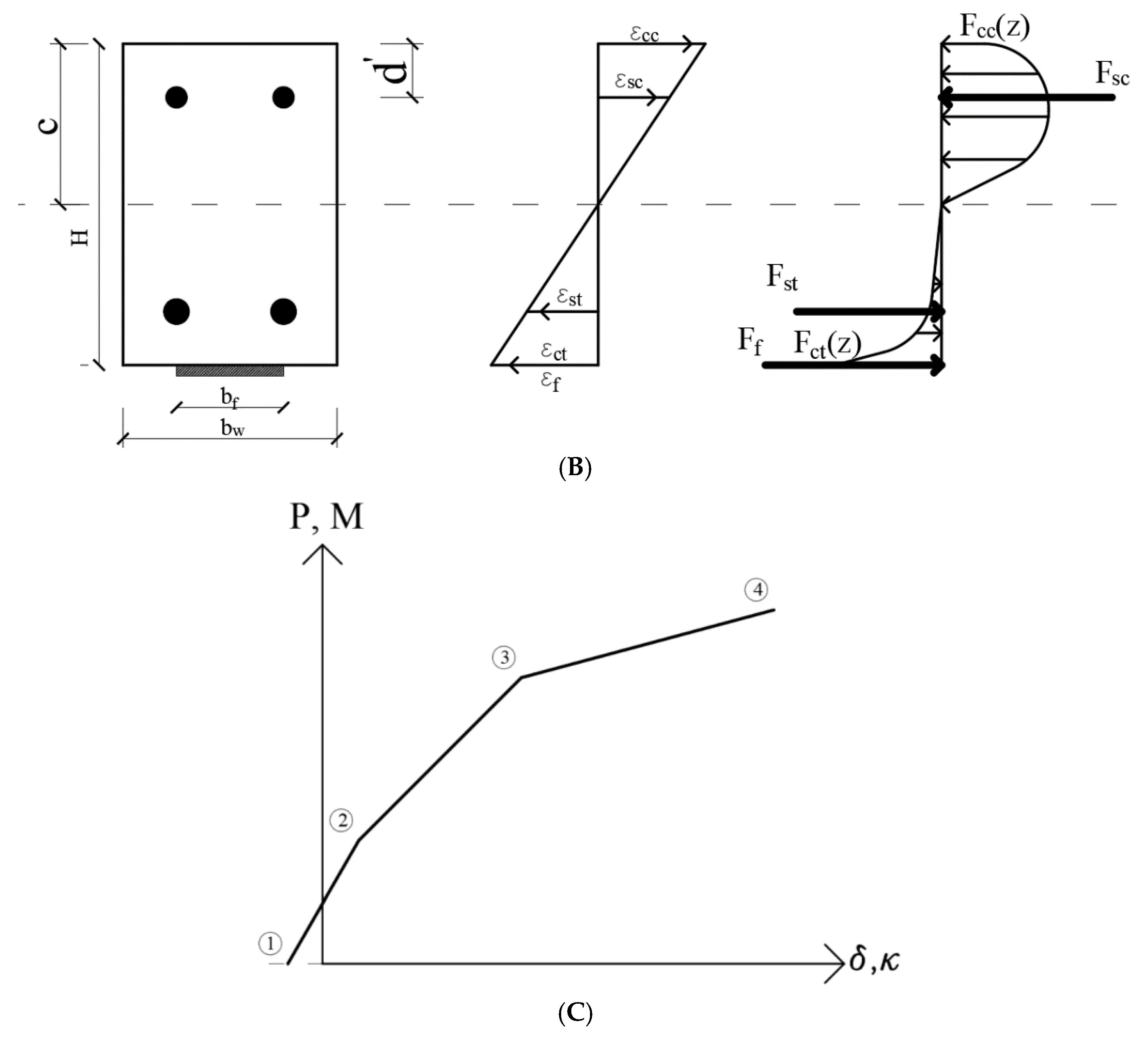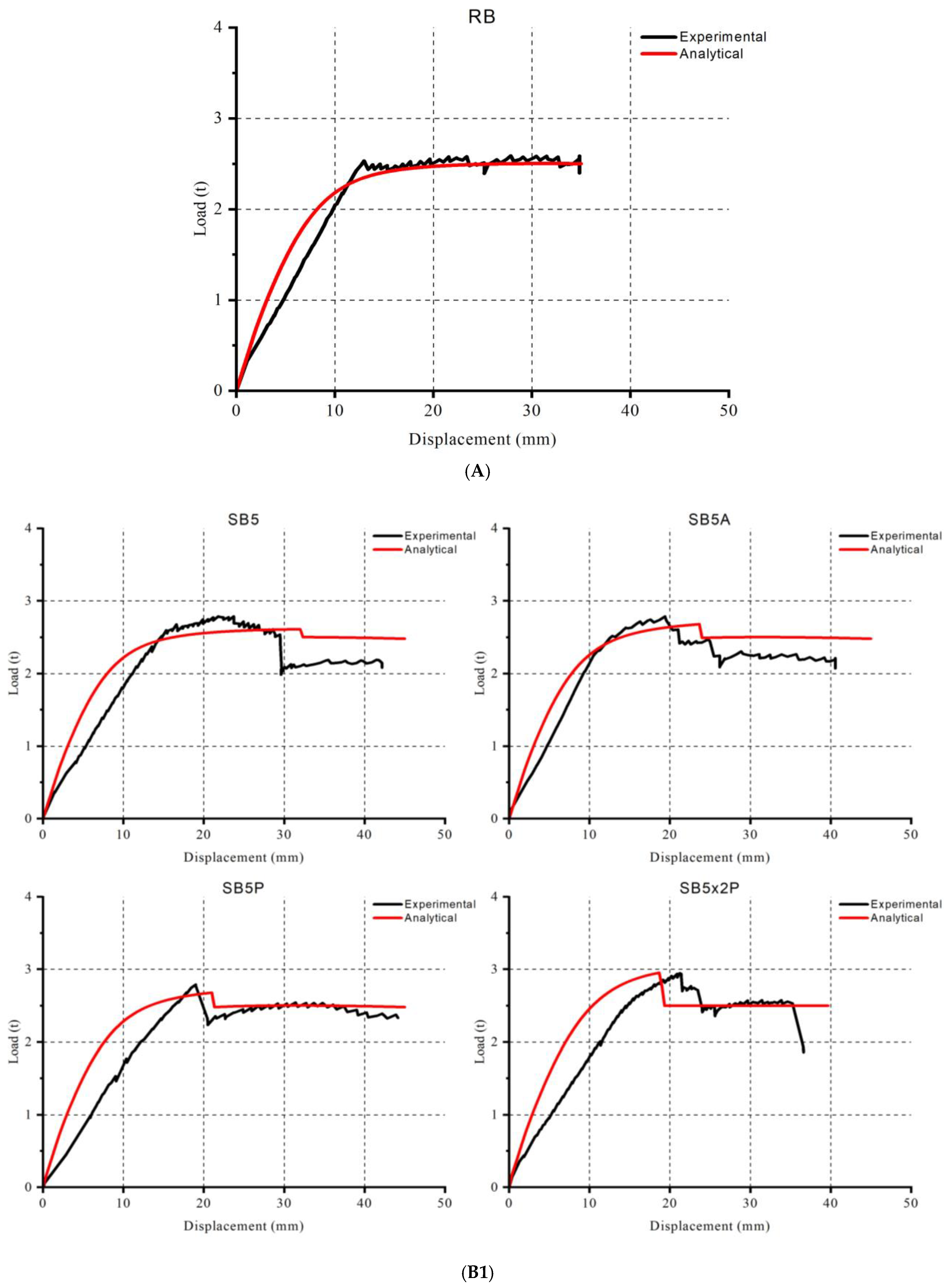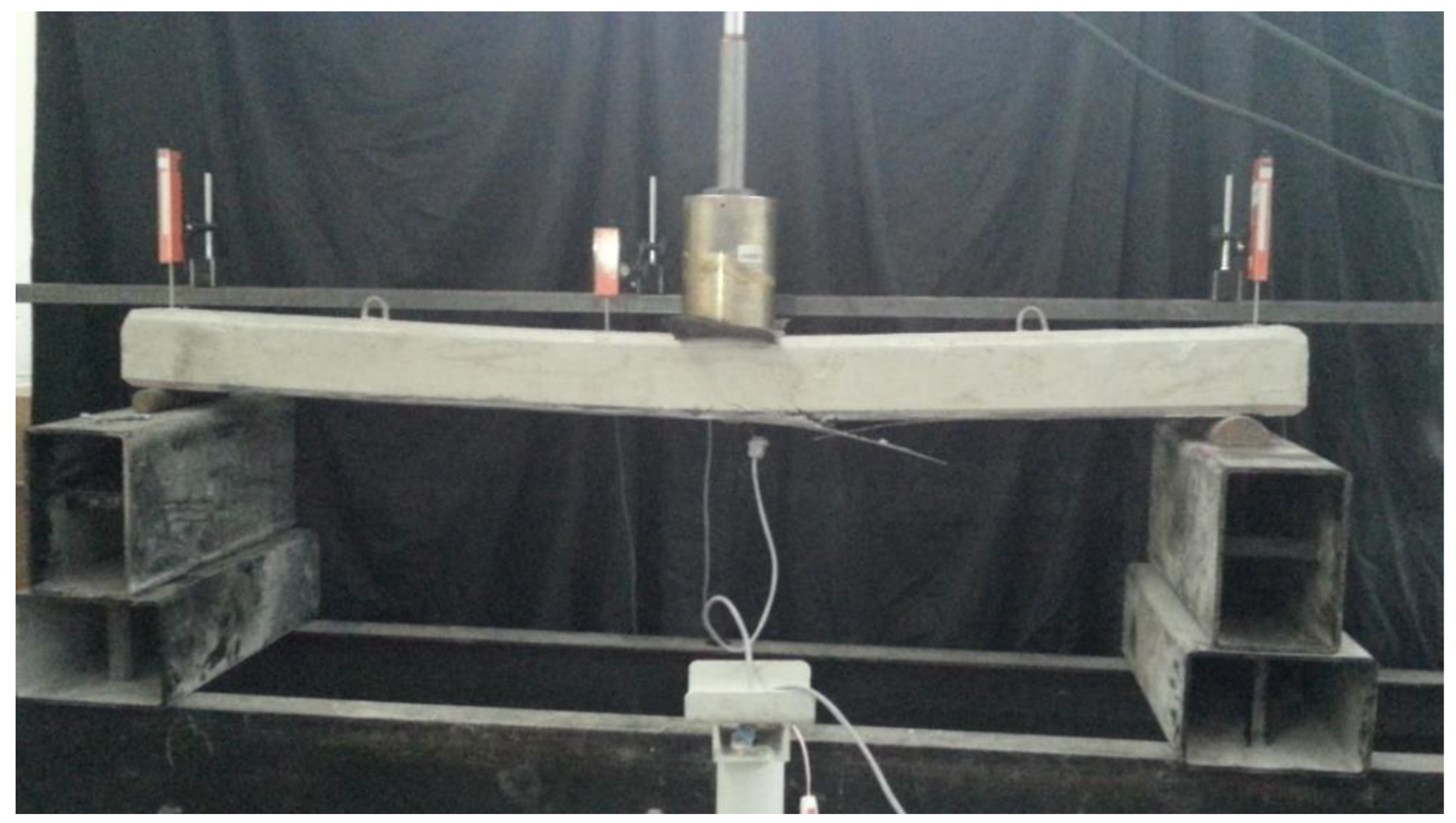Easy Prestressing of FRP for Strengthening RC Beams: Experimental Study with an Analytical Approach
Abstract
1. Introduction
2. Experimental Studies
3. Analytical Studies
Proposed Approach
4. Experimental and Analytical Results
5. Discussion
- Concrete Compressive Stress: Mander’s model effectively captured the concrete compressive stress, accurately predicting beam failure in nearly all samples.
- Concrete Tension Model: While the concrete tension model successfully captured the cracking load, it did not sufficiently represent the cracked section stiffness. The model’s sharp decrease after cracking suggests that a simpler stiffness-softening model based on a stress–strain diagram is inadequate for capturing the more complex behavior of the material.
- Rebar Model: The exponential rebar model was generally successful in predicting yielding load and corresponding ductility. However, a yield delay occurred due to the exponential decay, indicating that a sharper model, such as the elastic-perfectly plastic model, would be preferable for better accuracy.
- FRP Model: The FRP model was generally accurate, as FRP behaves like an elastic-brittle material. The model effectively captured the limiting strain, which was crucial for predicting FRP debonding.
6. Conclusions
Author Contributions
Funding
Institutional Review Board Statement
Data Availability Statement
Conflicts of Interest
Nomenclature
| P | load applied on the beam |
| midspan displacement of the beam | |
| L | span length |
| c | neutral axis depth |
| d′ | cover |
| H | beam section height |
| bf | width of FRP layer |
| bw | beam section width |
| concrete compressive strain | |
| rebar compressive strain | |
| rebar tensile strain | |
| concrete tensile strain | |
| frp strain | |
| concrete compressive stress | |
| rebar stress | |
| concrete tensile stress | |
| FRP stress | |
| M | moment |
| curvature | |
| curvature radius | |
| E | elastic modulus |
| effective moment of inertia | |
| d | effective depth |
| applied strain for prestressing | |
| transformed stress function of materials | |
| force of concrete in compressive zone | |
| force of rebar in compressive zone | |
| force of concrete in tension zone | |
| force of rebar in tension zone | |
| force of FRP | |
| neutral axis depth of i. iteration | |
| x | coefficient of Mander model depending on E and |
| r | coefficient of Mander model depending on E and |
| strain of concrete characteristic strength | |
| ultimate strain of concrete in compression | |
| secant modulus of concrete for inelastic region | |
| concrete characteristic compressive strength | |
| concrete characteristic tensile strength | |
| rebar yielding strength | |
| FRP ultimate strain | |
| number of FRP strip | |
| Fa | force of analytical result |
| Fe | force of experimental result |
Appendix A

References
- Amran, Y.M.; Alyousef, R.; Rashid, R.S.; Alabduljabbar, H.; Hung, C.C. Properties and applications of FRP in strengthening RC structures: A review. Structures 2018, 16, 208–238. [Google Scholar] [CrossRef]
- Khalifa, A.; Gold, W.J.; Nanni, A.; MI, A.A. Contribution of externally bonded FRP to shear capacity of RC flexural members. J. Compos. Constr. 1998, 2, 195–202. [Google Scholar] [CrossRef]
- Naser, M.Z.; Hawileh, R.A.; Abdalla, J.A. Fiber-reinforced polymer composites in strengthening reinforced concrete structures: A critical review. Eng. Struct. 2019, 198, 109542. [Google Scholar] [CrossRef]
- Spadea, G.; Bencardino, F.; Sorrenti, F.; Swamy, R.N. Structural effectiveness of FRP materials in strengthening RC beams. Eng. Struct. 2015, 99, 631–641. [Google Scholar] [CrossRef]
- Sakar, G. Shear Strengthening of RC Beams Subjected to Cyclic Load Using CFRP Strips. Adv. Compos. Lett. 2008, 17, 096369350801700604. [Google Scholar] [CrossRef]
- Sakar, G.; Alku, O.Z. Strengthening of RC T-Section Beams Subjected to Cyclic Load Using CFRP Sheets. Adv. Compos. Lett. 2008, 17, 191–202. [Google Scholar] [CrossRef]
- Askar, M.K.; Hassan, A.F.; Al-Kamaki, Y.S. Flexural and shear strengthening of reinforced concrete beams using FRP composites: A state of the art. Case Stud. Constr. Mater. 2022, 17, e01189. [Google Scholar] [CrossRef]
- Siddika, A.; Al Mamun, M.A.; Ferdous, W.; Alyousef, R. Performances, challenges and opportunities in strengthening reinforced concrete structures by using FRPs—A state-of-the-art review. Eng. Fail. Anal. 2020, 111, 104480. [Google Scholar] [CrossRef]
- Gudonis, E.; Timinskas, E.; Gribniak, V.; Kaklauskas, G.; Arnautov, A.K.; Tamulėnas, V. FRP reinforcement for concrete structures: State-of-the-art review of application and design. Eng. Struct. Technol. 2013, 5, 147–158. [Google Scholar] [CrossRef]
- Kang, T.H.K.; Howell, J.; Kim, S.; Lee, D.J. A state-of-the-art review on debonding failures of FRP laminates externally adhered to concrete. Int. J. Concr. Struct. Mater. 2012, 6, 123–134. [Google Scholar] [CrossRef]
- Teng, J.G.; Chen, J.F. Mechanics of debonding in FRP-plated RC beams. In Structures and Granular Solids; CRC Press: Boca Raton, FL, USA, 2008; pp. 325–338. [Google Scholar]
- Waghmare, S.; Shelare, S.; Aglawe, K.; Khope, P. A mini review on fibre reinforced polymer composites. Mater. Today Proc. 2022, 54, 682–689. [Google Scholar] [CrossRef]
- Teng, J.G.; Smith, S.T.; Yao, J.; Chen, J.F. Intermediate crack-induced debonding in RC beams and slabs. Constr. Build. Mater. 2003, 17, 447–462. [Google Scholar] [CrossRef]
- Moshiri, N.; Martinelli, E.; Breveglieri, M.; Czaderski, C. Experimental tests and numerical simulations on the mechanical response of RC slabs externally strengthened by passive and prestressed FRP strips. Eng. Struct. 2023, 292, 116559. [Google Scholar] [CrossRef]
- Grelle, S.V.; Sneed, L.H. Review of anchorage systems for externally bonded FRP laminates. Int. J. Concr. Struct. Mater. 2013, 7, 17–33. [Google Scholar] [CrossRef]
- Wang, Q.; Zhu, H.; Zhang, B.; Tong, Y.; Teng, F.; Su, W. Anchorage systems for reinforced concrete structures strengthened with fiber-reinforced polymer composites: State-of-the-art review. J. Reinf. Plast. Compos. 2020, 39, 327–344. [Google Scholar] [CrossRef]
- El-Hacha, R.; Awassa, O. Strengthening of Concrete Structures Using Prestressed FRP–A Review. In 10th International Conference on FRP Composites in Civil Engineering: Proceedings of CICE 2020/2021 10; Springer International Publishing: Cham, Switzerland, 2022; pp. 2209–2221. [Google Scholar] [CrossRef]
- Aslam, M.; Shafigh, P.; Jumaat, M.Z.; Shah, S.N.R. Strengthening of RC beams using prestressed fiber reinforced polymers–A review. Constr. Build. Mater. 2015, 82, 235–256. [Google Scholar] [CrossRef]
- Rezazadeh, M.; Barros, J.; Costa, I. Analytical approach for the flexural analysis of RC beams strengthened with prestressed CFRP. Compos. Part B Eng. 2015, 73, 16–34. [Google Scholar] [CrossRef]
- Kalfat, R.; Al-Mahaidi, R.; Smith, S.T. Anchorage devices used to improve the performance of reinforced concrete beams retrofitted with FRP composites: State-of-the-art review. J. Compos. Constr. 2013, 17, 14–33. [Google Scholar] [CrossRef]
- Beßling, M.; Czaderski, C.; Orlowsky, J. Prestressing effect of shape memory alloy reinforcements under serviceability tensile loads. Buildings 2021, 11, 101. [Google Scholar] [CrossRef]
- Ferrier, E.; Michel, L.; Jurkiewiez, B.; Hamelin, P. Creep behavior of adhesives used for external FRP strengthening of RC structures. Constr. Build. Mater. 2011, 25, 461–467. [Google Scholar] [CrossRef]
- Şakar, G.; Tanarslan, H.M. Prestressed CFRP fabrics for flexural strengthening of concrete beams with an easy prestressing technique. Mech. Compos. Mater. 2014, 50, 537–542. [Google Scholar] [CrossRef]
- American Concrete Institute. Guide for the Design and Construction of Externally Bonded FRP Systems for Strengthening Concrete Structures (ACI 440.2R-23); ACI: Farmington Hills, MI, USA, 2023. [Google Scholar]
- Pešić, N.; Pilakoutas, K. Flexural analysis and design of reinforced concrete beams with externally bonded FRP reinforcement. Mater. Struct. 2005, 38, 183–192. [Google Scholar] [CrossRef]
- Pellegrino, C.; Modena, C. Flexural Strengthening of Real-Scale RC and PRC Beams with End-Anchored Pretensioned FRP Laminates. ACI Struct. J. 2009, 106, S31. [Google Scholar]
- Wang, W.W.; Dai, J.G.; Harries, K.A. Intermediate crack-induced debonding in RC beams externally strengthened with prestressed FRP laminates. J. Reinf. Plast. Compos. 2013, 32, 1842–1857. [Google Scholar] [CrossRef]
- Al-Zaid, R.Z.; Al-Negheimish, A.I.; Al-Saawani, M.A.; El-Sayed, A.K. Analytical study on RC beams strengthened for flexure with externally bonded FRP reinforcement. Compos. Part B Eng. 2012, 43, 129–141. [Google Scholar] [CrossRef]
- Ali, M.M. Analytical models to predict structural behaviour of reinforced concrete beams bonded with prestressed fibre-reinforced polymer laminates. Adv. Struct. Eng. 2018, 21, 532–544. [Google Scholar] [CrossRef]
- Oehlers, D.J.; Visintin, P.; Lucas, W. Fundamental mechanics governing FRP-retrofitted RC beams with anchored and prestressed FRP plates. J. Compos. Constr. 2016, 20, 04016047. [Google Scholar] [CrossRef]
- Wang, Y.C.; Chen, C.H. Analytical study on reinforced concrete beams strengthened for flexure and shear with composite plates. Compos. Struct. 2003, 59, 137–148. [Google Scholar] [CrossRef]
- Razaqpur, A.G.; Lamberti, M.; Ascione, F. Debonding evolution in nonlinear FRP-retrofitted RC beams with cohesive interface. Compos. Struct. 2020, 236, 111858. [Google Scholar] [CrossRef]
- An, W.; Saadatmanesh, H.; Ehsani, M.R. RC beams strengthened with FRP plates. II: Analysis and parametric study. J. Struct. Eng. 1991, 117, 3434–3455. [Google Scholar] [CrossRef]
- Mander, J.B.; Priestley, M.J.; Park, R. Theoretical stress-strain model for confined concrete. J. Struct. Eng. 1988, 114, 1804–1826. [Google Scholar] [CrossRef]
- MathWorks, Inc. MATLAB—The Language of Technical Computing, Version R2024a; The MathWorks Inc.: Natick, MA, USA, 2024. Available online: https://www.mathworks.com/ (accessed on 9 June 2025).










| Abbreviation of Sample | Width of FRP | Number of Layers | Anchoring | Prestressing |
|---|---|---|---|---|
| RB | - | - | - | - |
| SB5 | 50 mm | Single | - | - |
| SB5x2A | 50 mm | Double | U-strip | - |
| SB5P | 50 mm | Single | U-strip | 0.001 mm/mm |
| SB5x2P | 50 mm | Double | U-strip | 0.001 mm/mm |
| SB10 | 100 mm | Single | - | - |
| SB10x2A | 100 mm | Double | U-strip | - |
| SB10P | 100 mm | Single | U-strip | 0.001 mm/mm |
| SB10x2P | 100 mm | Double | U-strip | 0.001 mm/mm |
| Specimen | Ultimate Load (Experimental) (t) | Ultimate Load (Analytical) (t) | Difference (%) | Pearson Coefficient |
|---|---|---|---|---|
| RB | 2.59 | 2.5 | 3.5 | 0.99 |
| SB5 | 2.78 | 2.61 | 6 | 0.91 |
| SB5A | 2.79 | 2.68 | 4 | 0.95 |
| SB5P | 2.79 | 2.68 | 4 | 0.82 |
| SB5x2P | 2.94 | 2.94 | 0 | 0.87 |
| SB10 | 2.9 | 2.85 | 2 | 0.9 |
| SB10x2A | 2.96 | 3.21 | 7.8 | 0.89 |
| SB10P | 3.33 | 3.16 | 5.1 | 0.91 |
| SB10x2P | 3.75 | 3.43 | 8.5 | 0.91 |
Disclaimer/Publisher’s Note: The statements, opinions and data contained in all publications are solely those of the individual author(s) and contributor(s) and not of MDPI and/or the editor(s). MDPI and/or the editor(s) disclaim responsibility for any injury to people or property resulting from any ideas, methods, instructions or products referred to in the content. |
© 2025 by the authors. Licensee MDPI, Basel, Switzerland. This article is an open access article distributed under the terms and conditions of the Creative Commons Attribution (CC BY) license (https://creativecommons.org/licenses/by/4.0/).
Share and Cite
Sakar, G.; Celik, H.K. Easy Prestressing of FRP for Strengthening RC Beams: Experimental Study with an Analytical Approach. Polymers 2025, 17, 1628. https://doi.org/10.3390/polym17121628
Sakar G, Celik HK. Easy Prestressing of FRP for Strengthening RC Beams: Experimental Study with an Analytical Approach. Polymers. 2025; 17(12):1628. https://doi.org/10.3390/polym17121628
Chicago/Turabian StyleSakar, Gokhan, and Huseyin Kursat Celik. 2025. "Easy Prestressing of FRP for Strengthening RC Beams: Experimental Study with an Analytical Approach" Polymers 17, no. 12: 1628. https://doi.org/10.3390/polym17121628
APA StyleSakar, G., & Celik, H. K. (2025). Easy Prestressing of FRP for Strengthening RC Beams: Experimental Study with an Analytical Approach. Polymers, 17(12), 1628. https://doi.org/10.3390/polym17121628






